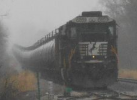order of passenger cars...does it matter?
Re: order of passenger cars...does it matter?
Many long distance trains used an order similar to this:
RPO
Baggage
Coaches
Diner
Sleeping Cars
Lounge
Observation
There were lots of variations, so anything goes...
RPO
Baggage
Coaches
Diner
Sleeping Cars
Lounge
Observation
There were lots of variations, so anything goes...
-

harryadkins - Posts: 3114
- Joined: Sun Aug 23, 2009 8:01 am
- Location: South Carolina, USA
Re: order of passenger cars...does it matter?
If your running Amtrak trains then this may be of help.
http://discuss.amtraktrains.com/index.p ... -listings/
http://discuss.amtraktrains.com/index.p ... -listings/
"If you really needed a diesel locomotive right away, then go ahead and order a ALCO. But if you could wait for real quality, then go for an EMD or a GE".
My Youtube Channel (Railfanning and Train Simulator 2018)
http://www.youtube.com/user/3985gtasa
http://www.youtube.com/user/3985gtasa
-

bpetit - Posts: 1985
- Joined: Sun Sep 19, 2010 9:44 pm
- Location: New Orleans, Louisiana
Re: order of passenger cars...does it matter?
hmm. I'll bookmark it. Never though how Amtrak setup their trains. 

Hi! I'm Daniel (37). A casual Train Simulator Streamer and Railfanner. 4+ hours of Fun and Adventure with Laughter, Reactions and SoundFX.
CSX2057 YOUTUBE CHANNEL
CSX2057 YOUTUBE CHANNEL
-

CSX2057 - Posts: 1383
- Joined: Tue Jun 07, 2011 11:18 am
- Location: Georgia
Re: order of passenger cars...does it matter?
In the old days the diner was forward to take advantage of the good hot steam.
Buzz
39 and holding.
"Some people find fault like there's a reward for it."- Zig Ziglar
"If you can dream it you can do it."- Walt Disney

39 and holding.
"Some people find fault like there's a reward for it."- Zig Ziglar
"If you can dream it you can do it."- Walt Disney

-

buzz456 - Site Admin
- Posts: 21020
- Joined: Sun Mar 21, 2010 8:30 am
- Location: SW Florida
Re: order of passenger cars...does it matter?
Now something I gata ask, Now I'm gonna be going on steam engines I'm thinking of using superliners for the steam engines. I might do a little Amtrak repaint on a steam from G-Trax. (I might idk) Do I have to have a diesel in the rear of the tender to provide electricity like AC and stuff? or can I go for it without diesel?
Hi! I'm Daniel (37). A casual Train Simulator Streamer and Railfanner. 4+ hours of Fun and Adventure with Laughter, Reactions and SoundFX.
CSX2057 YOUTUBE CHANNEL
CSX2057 YOUTUBE CHANNEL
-

CSX2057 - Posts: 1383
- Joined: Tue Jun 07, 2011 11:18 am
- Location: Georgia
Re: order of passenger cars...does it matter?
Depends if the steam engine has a steam generator. But it doesn't work on railworks so you could assume it has one
"If you really needed a diesel locomotive right away, then go ahead and order a ALCO. But if you could wait for real quality, then go for an EMD or a GE".
My Youtube Channel (Railfanning and Train Simulator 2018)
http://www.youtube.com/user/3985gtasa
http://www.youtube.com/user/3985gtasa
-

bpetit - Posts: 1985
- Joined: Sun Sep 19, 2010 9:44 pm
- Location: New Orleans, Louisiana
Re: order of passenger cars...does it matter?
bpetit wrote:Depends if the steam engine has a steam generator. But it doesn't work on railworks so you could assume it has one
The Amtrak cars have individual propane car heat and hot water generation. The hotel electrical power for lights and air conditioning comes from the head end, so there would need to be some sort of a generator car (a Modded boxcar?) to supply the electricity. UP has a full on generator car made from a 50' boxcar on their excursion setup. Another option would be to fix up an F7 B unit as a generator car. I know rail grinding services use them for gen sets.
- MadMike1024
- Global Mod
- Posts: 1730
- Joined: Fri Jul 30, 2010 8:11 pm
- Location: Vancouver, WA
Re: order of passenger cars...does it matter?
MadMike1024 wrote:bpetit wrote:Depends if the steam engine has a steam generator. But it doesn't work on railworks so you could assume it has one
The Amtrak cars have individual propane car heat and hot water generation. The hotel electrical power for lights and air conditioning comes from the head end, so there would need to be some sort of a generator car (a Modded boxcar?) to supply the electricity. UP has a full on generator car made from a 50' boxcar on their excursion setup. Another option would be to fix up an F7 B unit as a generator car. I know rail grinding services use them for gen sets.
Something like that. That's what I need to setup my steams passengers.
Hi! I'm Daniel (37). A casual Train Simulator Streamer and Railfanner. 4+ hours of Fun and Adventure with Laughter, Reactions and SoundFX.
CSX2057 YOUTUBE CHANNEL
CSX2057 YOUTUBE CHANNEL
-

CSX2057 - Posts: 1383
- Joined: Tue Jun 07, 2011 11:18 am
- Location: Georgia
Re: order of passenger cars...does it matter?
Wikipedia is sometimes a good source to find basic consist information for older Name Trains. The Railroad Historical Societies often have good information too. It's sometimes a bit confusing at first since not all trains ran the same consist all the way through, with cars sometimes being exchanged with other trains along the route.
Cheers!
Michael
Cheers!
Michael
-

GreatNortherner - Posts: 1585
- Joined: Sun Feb 15, 2009 11:19 am
- Location: Czech Republic
Re: order of passenger cars...does it matter?
Every passenger train I was on before Amtrak came along had the diner right behind the baggage/rpo cars. You walked from the rear through the compartments then through the dome car (if there was one) into the coaches and then to the diner.
Buzz
39 and holding.
"Some people find fault like there's a reward for it."- Zig Ziglar
"If you can dream it you can do it."- Walt Disney

39 and holding.
"Some people find fault like there's a reward for it."- Zig Ziglar
"If you can dream it you can do it."- Walt Disney

-

buzz456 - Site Admin
- Posts: 21020
- Joined: Sun Mar 21, 2010 8:30 am
- Location: SW Florida
Re: order of passenger cars...does it matter?
harryadkins wrote:Many long distance trains used an order similar to this:
RPO
Baggage
Coaches
Diner
Sleeping Cars
Lounge
Observation
There were lots of variations, so anything goes...
To amplify on Harry's comments, as a pretty hard and fast rule into the mid-'60s, when RPO routes began to disappear rapidly, the working RPO was always the first car after the power, so that if anything happened to disable the train, the power and the RPO would cut off and run on schedule. The was a matter of U.S. Post Office regulation. The only exception to that was when the express cars (either dedicated baggage cars or passenger-equipped boxcars and refrigerators) ahead of the PRO were carrying storage mail, which is what mail that was pre-sorted and bagged by destination was called back in those days. In such a case, these cars would accompany the working RPO if the train was disabled. Following these were typically cars in Railway Express Agency service, and then the working and non-working baggage cars. This is the primary reason you'll see these types of cars referred to as "head end cars" in the most of the popular railway literature.
Most long distance trains I rode placed the dining car between the coaches and first-class (sleeping or parlor cars) for a variety of reasons, but the roots of the practice are found in most railroads' first class service being operated by the Pullman Company (this was prior to the Government breakup of Pullman in the early-'50s), and therefore hauled by contract. Lounge cars, typically also operated by Pullman, were typically placed in the middle of the sleeping cars, and most observation cars also functioned as lounge cars, typically serving drinks and light snacks. In some cases, the Pullman Company also operated the train's dining car service. There were exceptions to this, typically in the cases of trains that dropped and/or added sections to other destination en-route. The New Haven tended to run their parlor cars between New York and Boston on the head end (probably to minimize the walk to the station concourse at Grand Central and South Station, while running them in the more conventional position on through trains from the Pennsy and the northern New England carriers. Some railroads' premium trains ran two dining cars, kitchen-to-kitchen, and both the NYC and the Pennsy ultimately replaced this practice with twin-unit diners.
By the early-'60s, most of the premium services had disappeared, and the order of passenger-carrying cars in the consist became more a matter of convenience for the yard crews. I remember dining cars placed right behind the head-end cars (railroad commissary operations were often adjacent to the mail, express and baggage facilities), and I've seen them on the rear end of the consist, for apparent reason that I could discern, unless the car was being turned at an intermediate station for service in the return direction. Southern did something like this is the latter days of the Southern Crescent, west of Atlanta: the diner was always second-last, in front of the dome, because the diners and the dome turned at Atlanta by that time, and this was a convenient way to add and drop the cars on the western part of the run.
-

philmoberg - Posts: 425
- Joined: Fri Feb 20, 2009 8:50 pm
Re: order of passenger cars...does it matter?
Excellent thread! I'm learning a lot from it.
-

mrennie - Posts: 3214
- Joined: Wed May 30, 2012 12:22 pm
Re: order of passenger cars...does it matter?
All my rides were on the 'City of' trains run by milwaukee, D&RG, UP out of Chicago headed ultimately for the west coast and one trip to Florida on I don't know what other than part of the trip was over L&N tracks and they were all configured like I described earlier.
Buzz
39 and holding.
"Some people find fault like there's a reward for it."- Zig Ziglar
"If you can dream it you can do it."- Walt Disney

39 and holding.
"Some people find fault like there's a reward for it."- Zig Ziglar
"If you can dream it you can do it."- Walt Disney

-

buzz456 - Site Admin
- Posts: 21020
- Joined: Sun Mar 21, 2010 8:30 am
- Location: SW Florida
Re: order of passenger cars...does it matter?
Does anyone know what the UP City of LA did with putting their monster passenger trains together? In the pictures I see, there are some 6 cars spread out! Maybe...25 cars?
-

1225fan5358 - Posts: 1113
- Joined: Mon Dec 26, 2011 3:33 pm
- Location: Grand Rapids, MI, United States
Re: order of passenger cars...does it matter?
"Just prior to the start of World War II both the City of L.A. and City of S.F. were upgraded with EMC E6As and E6Bs. Similar to the earlier E2 model the E6s
featured a more slanted nose and increased horsepower. The original City of L.A. consist included 14 cars featuring a club-dormitory, sleepers,
coaches, an observation-lounge, and perhaps the train's marquee piece an articulated diner-coffee shop (the diner section could seat 64). The City of Los Angeles
was also the first streamliner to feature Pullman's new round-end observation, adding to the train's sleek look."
( http://www.american-rails.com/city-of-los-angeles.html)
featured a more slanted nose and increased horsepower. The original City of L.A. consist included 14 cars featuring a club-dormitory, sleepers,
coaches, an observation-lounge, and perhaps the train's marquee piece an articulated diner-coffee shop (the diner section could seat 64). The City of Los Angeles
was also the first streamliner to feature Pullman's new round-end observation, adding to the train's sleek look."
( http://www.american-rails.com/city-of-los-angeles.html)
“To alcohol - The cause of - And the solution to all of life's problems” Homer Simpson.
-

BlueLight - Posts: 296
- Joined: Tue Mar 20, 2012 11:34 am
- Location: Kansas City, Missouri
16 posts
• Page 1 of 2 • 1, 2
Who is online
Users browsing this forum: No registered users and 1 guest
